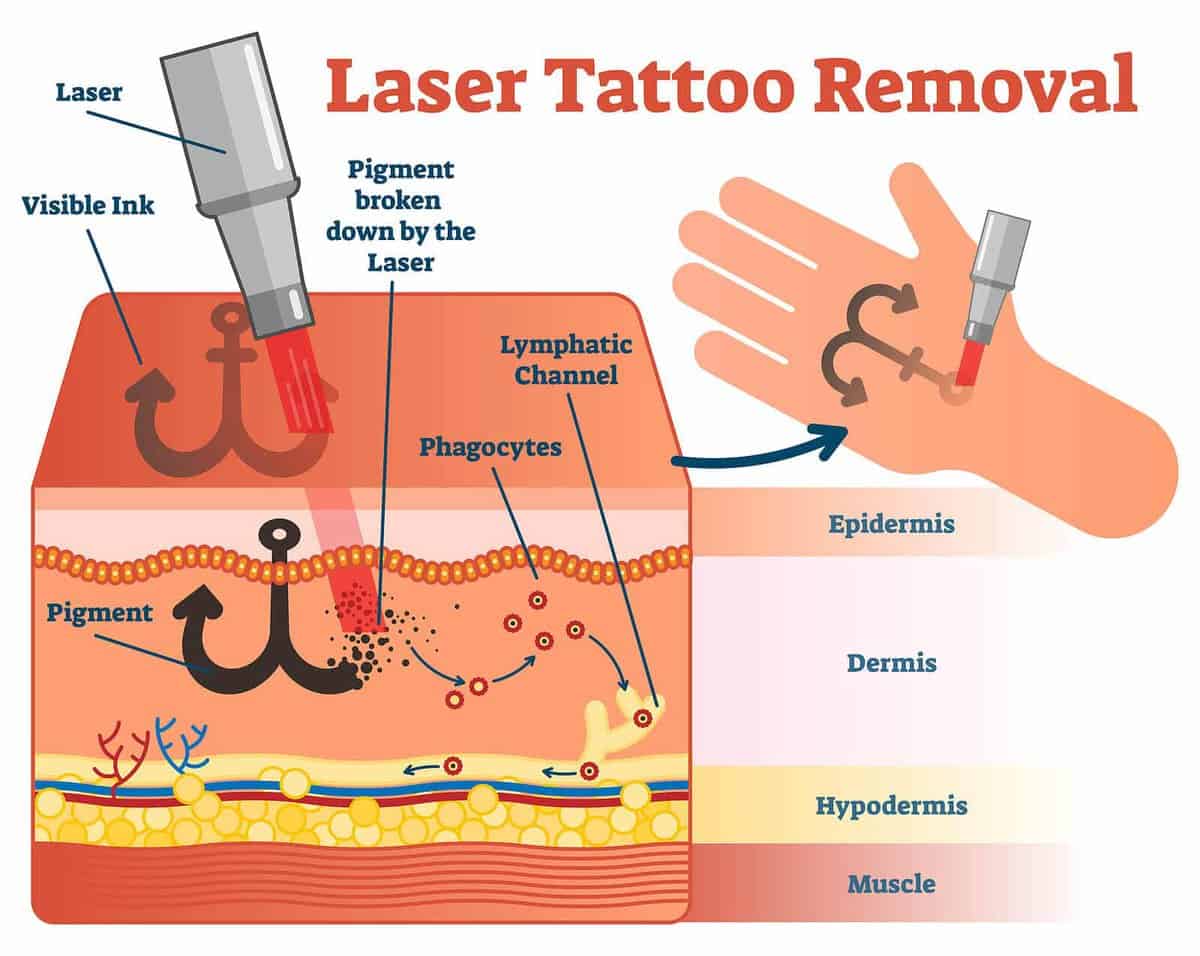Let’s work on your tattoo removal together!
Transform Regrets into Fresh Starts with Expert Tattoo Removal.
How does laser tattoo removal work? Firstly, let’s take a step back and understand how tattoos work. The tattoo pigment is placed in the Dermis. This is the deeper layers of the skin. The ink particles are quite large. And cannot be absorbed by the body here. This is why the ink is permanent. And visible.
The removal process works by directing the laser light onto the tattoo. The laser wavelength is adjusted based on ink colour. Black ink or darker inks are the easiest to remove or fade.
This is because black and darker inks absorb all wavelengths of light. When you consider the colour spectrum, black ink absorbs the laser light, while white reflects it. Warmer tones like reds may take longer to break down than black ink, and blues and greens tend to take a bit longer as well.
The tattoo ink absorbs the laser light, and the ink particles are shattered into tiny little particles.
The Tattoo Removal Elimination Process
The shattered ink is then eliminated through the lymphatic system. This is the body’s natural cleansing system. Every tattoo is different, and so is every individual. The number of treatments needed is determined by a few factors.
How many tattoo removal treatments will you need?
Now you have a better idea of the tattoo removal process. Next let’s look at how many treatments you might need.
On average, it can take between 6-10 treatments to remove or fade a tattoo. Some people need more and some people need less. And this can vary from person to person. Based on the below factors;
Tattoo Colours and Their Impact on Tattoo Removal
Tattoo colour plays a big role in how fast ink fades. Black ink is the easiest to get rid of. Followed by reds and warmer tones. And then blues and greens, being the hardest to get rid of.
Your Skin Tone and Laser Treatment Results
When it comes to laser tattoo removal, we refer to the Fitzpatrick Skin Scale to estimate how many treatments you’ll need. There are 6 different skin types. Ranging from light, pale white to very dark. Tattoos on very light, fair skin can see quicker results.
Removing Layered Tattoos: What to Expect
With laser tattoo removal, we can only treat one layer at a time. So if you have a tattoo on top of a tattoo, this just means we need to target that many more layers of ink. And it may need more treatments.
Tattoo Placement On the Body and Its Impact on Fading
Tattoos in certain parts of the body may fade quicker than others. The higher the circulation, the quicker the tattoo can fade. Closer to the heart, the quicker we might see results. This is why tattoos on hands and feet may take a bit longer.
How Your Health Affects Laser Treatment
Health and Lifestyle plays a major role in getting rid of that ink. For example, let’s take smoking and drinking regularly. Your body has to deal with getting rid of the nasty toxins. And may not have the detox capacity to get rid of all that ink. Therefore, this can slow the process and result in more treatments.
Does More Ink Mean More Removal Sessions?
Are we looking at a tattoo with very faint lines. Or a tattoo that is dense and has a lot of ink.
Older vs. Newer Tattoos: Which Fade Faster?
Older tattoos can be easier to shift. Because the body is already trying to break that ink down over the years. This is why a tattoo that is 20 years old will look more faded. Compared to a tattoo that might only be 6 weeks old.
Differences in Removing Pro vs. Amateur Ink
Professional tattoos are a lot more harder to get rid of. Why? Because they are professional! And when a tattoo is done professionally, the tattoo artist is able to place the ink deeper in the Dermis. The Dermis is the deeper layer of the skin. If a tattoo is done with a tattoo gun by a friend, the ink may not have been placed so deep into the Dermis. So this type of tattoo may not need as many treatments. Similarly Stick and Poke tattoos are easy to get rid of. Because the ink hasn’t been placed so deep.
Does tattoo removal work?
Yes, tattoo removal can work, but the success depends on several factors, as discussed above.
Most tattoos require multiple sessions, spaced out 6-8 weeks apart, to achieve significant fading or full removal. While the process is effective for most tattoos, some colours, especially light or stubborn ones like yellow and green, can be more challenging to remove.
There may also be some residual scarring or discoloration, though this is generally minimal if proper aftercare is taken during the healing process. Consulting with a professional who specialises in tattoo removal is important to determine what to expect for your specific situation.
A few things to consider
Now you know how laser tattoo removal works, it is easy to understand why everyone reacts differently to tattoo removal. Because everyone is different. And so is every tattoo.
At Goodbye Tattoos, we carry out a skin assessment at the consultation. This way we can estimate how many tattoo removal treatments you might need. This just an estimate. We won’t know how you’ll react. Or how quickly the tattoo will fade until we have done a treatment.
In some cases, the tattoo may need 2-3 treatments before we seeing any fading. This doesn’t mean it’s not working. It just means, we need to break the ink down further.
Speeding up the laser tattoo removal process
There are ways to help speed up the tattoo removal process. And our goal is to get rid of your tattoo in as fewer treatments as possible. But there is some ‘homework’ to be done. By following some very simple tips, you’ll be saying goodbye to your unwanted tattoo before you know it.
Tattoo removal is a journey. And if you remain consistent, the results can be so worth it.
Ready to start your tattoo removal journey?
At Goodbye Tattoos, our laser tattoo removal specialists will take you through all the information you need. And are happy to answer your questions. So if you’re looking for laser tattoo removal in Sydney, get in touch with Goodbye Tattoos today. Call us today email info@goodbyetattoo.com. For more information see our FAQ page.


